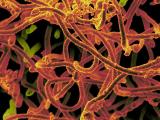Nov 20, 2007 (CIDRAP News) The Democratic Republic of the Congo's (DRC's) health ministry said today that its recent Ebola hemorrhagic fever outbreak has been contained and that the number of confirmed cases turned out to be lower than previously reported.
"We can say today that the Ebola epidemic has been completely subdued," health minister Makwenge Kaput said, alluding to the World Health Organization's (WHO) requirement for declaring an end to the outbreak, the Associated Press (AP) reported.
In an Oct 3 statement, the WHO said the country had to wait two consecutive incubation periods, or 42 days, after identification and isolation of the last case-patient before the outbreak could be considered controlled.
The health ministry said the outbreak involved 17 cases and 6 deathsfewer than the 25 cases it reported to the WHO in early October, the AP report said.
Vital Mondonge, another health ministry official, told the AP it was initially difficult to gauge the size of the outbreak because some of the sick people had diseases with symptoms similar to Ebola, including typhoid, malaria, and Shigella dysenteriae type 1.
The Ebola outbreak, which began in August and was centered in the DRC's Kasai Occidental (West Kasai) province, prompted an outpouring of international medical assistance after reports that hundreds of people were sick and more than 170 had died.
The Ebola virus is highly contagious and is lethal in about 50% to 90% of cases. Initial symptoms include fever, headache, joint and muscle aches, sore throat, and weakness, followed by diarrhea, vomiting, and stomach pain, according to the US Centers for Disease Control and Prevention (CDC). Some experience internal and external bleeding. There is no vaccine or specific treatment for the disease.
In other Ebola developments, French researchers recently identified a new genetic lineage of the Zaire variety of the Ebola virus, the type responsible for 88% of human deaths from the disease. The group published its findings in the Oct 23 issue of the Proceedings of the National Academy of Sciences.
The researchers found the new lineage, which they named lineage B, in samples taken from animal carcasses in Gabon and the Republic of the Congo between 2001 and 2006. Seven primatesone chimpanzee and six gorillaswere infected with lineage B, which they say differs from the previously known strain by 2% to 3%.
The researchers estimated that lineage B diverged from the previously known lineage about the time of the first recognized human outbreak in 1976. They also said their results show that wild Ebola strains are capable of recombination, and they estimated that the viruses recombined sometime between 1996 and 2001.
Two recent Ebola outbreaks in the Republic of the Congo involved lineage B, they reported: one in Mandza in November 2003 and one in Etoumbi in May 2005.
The emergence of different lineages suggests that the Zaire strain of Ebola was introduced repeatedly to human and animal populations in the last 30 years, the authors concluded.
See also:
Oct 3 WHO Ebola update
Sep 25 CIDRAP News story "Ebola cases in Congo rise to 17"
Whittmann TJ, Biek R, Hassanian A, et al. Isolates of Zaire ebolavirus from wild apes reveal genetic lineage and recombinants. Proc Natl Acad Sci 2007 Oct 23:104(43):17123-27 [Abstract]

















